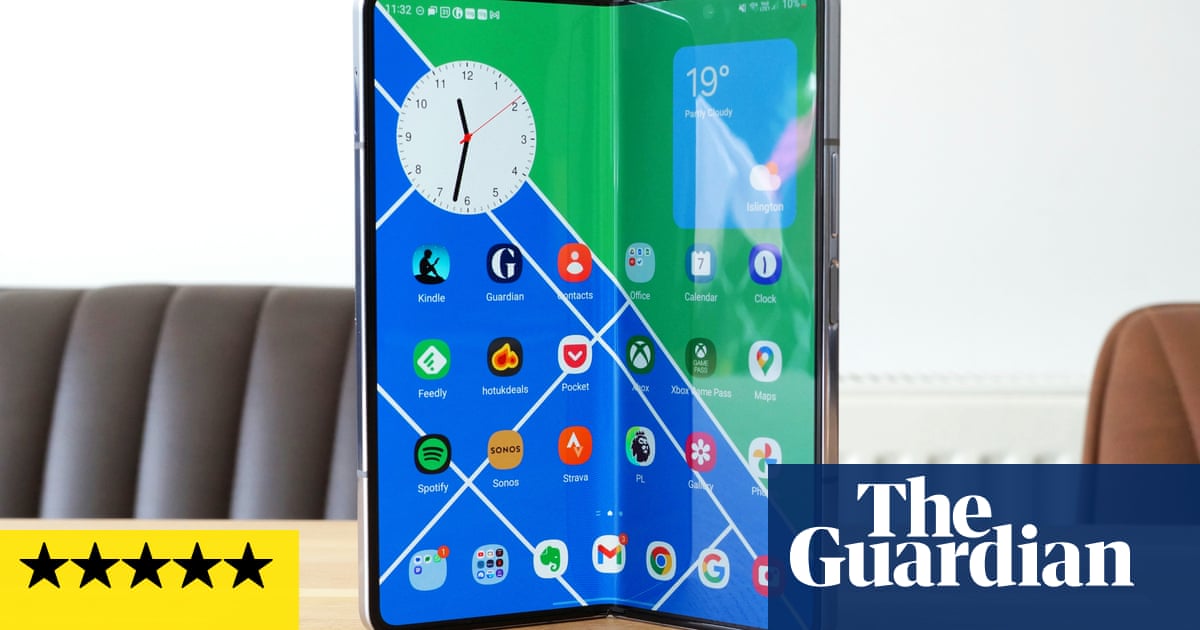
Lenovo’s ThinkPad X1 Fold is an entirely new form – a tablet PC that closes like a book with a foldable screen. It may just be the future of the computer.
The £2,500-plus X1 Fold joins a rarefied group of cutting edge folding-screen devices that include the reinvention of the flip phone and a mobile tablet that folds in half to fit in your pocket.
Other than hefty price tags, they all have one thing in common: big screens that fold into more compact shapes. The leather-bound X1 Fold is about the size of a large paperback book when closed, but opens fully to reveal a gorgeous 13.3in OLED screen about the same as a laptop.
The way it opens and closes is pure sci-fi. But fully unfolded it is remarkable how mundane the X1 Fold appears to be: it looks and works like any other flat Windows tablet such as Microsoft’s Surface Pro with a kickstand out the back to prop it up. Just getting to that level of normality for something quite so exotic as this is an impressive achievement.
You can’t see a crease down the middle at all with the screen on, and only if you position a bright light at just the right angle can you see it with the screen off. You have to push pretty hard on the centre with your finger to feel it too. It’s much less obvious than other folding-screen devices. The screen is crisp, good-looking and great for indoor working, but it isn’t quite bright enough to see in direct sunlight.
Tablet mode works great at a desk with an ample screen for getting work done. But when you want to move to kitchen table or the sofa, just fold the screen into a laptop configuration and the hinge will hold it there. The top half acts as the screen and the bottom can either display a second screen, such as Zoom up top with notes on the bottom, or a virtual keyboard. You can also use Lenovo’s optional mini Bluetooth keyboard, which snaps into place via magnets covering half the screen.
With the keyboard in place the X1 Fold behaves like a very small but surprisingly capable laptop. The top screen may only be 9.5in on the diagonal, but its 1,536 x 1,204 resolution is not dissimilar to many mid-range laptops, which means apps and sites work as normal. The super-compact nature would make it ideal for use on a plane or train on cramped seat trays.
When work is done you can ditch the keyboard and use it like a book. A pdf or Word document or Kindle book via Amazon’s Cloud Reader set to show two pages on screen in landscape is a pretty good fit for the two halves of the screen. And of course it functions as a handheld tablet just fine for watching Netflix or Amazon Prime. Finally, you can use Lenovo’s Mod Pen for sketching or signing documents, which works just as well as other top PC styluses.
There are many multi-talented devices available, but none of them operate quite like the X1 Fold. The outside sliding leather cover, the sturdy magnesium body and great screen make the Lenovo feel like it is worth its hefty sum.
Specifications
Screen: 13.3in flexible OLED 2,048 x 1,536 (192PPI)
Processor: Intel Core i5-L16G7
RAM: 8GB
Storage: 256, 512GB or 1TB SSD
Graphics: Intel UHD
Operating system: Windows 10 Home or Pro
Camera: 5MP front-facing
Connectivity: wifi 6 (ax), Bluetooth 5.1, optional 5G, 2xUSB-C (Gen 2),
Dimensions unfolded: 299.4 x 236.0 x 11.5mm
Dimensions folded: 158.2 x 236.0 x 27.8mm
Weight: 999g
Solid performance and 5.5-hour battery life
The X1 Fold has Intel’s Core i5 hybrid processor, which is a lower-power chip than the regular Core i5 found in most laptops. It was first used in the Samsung Galaxy Book S, which had a slightly disappointing performance.
The X1 Fold handles surprisingly well, however. It won’t win any raw performance awards, but it was generally snappy and perfectly capable of doing everything I asked of it, from fairly complex edits in Affinity Photo to wrangling 30 tabs in Chrome. It has fans but I heard them only when the machine was doing updates.
The battery lasts about 5.5 hours of work in laptop or desktop mode, or closer to 6.5 hours just used for browsing as a tablet, which is a little shorter than the eight-plus hours expected of a regular Windows tablet.
The compromises
As remarkably well as the X1 Fold works, there are some compromises that have had to be made to get it to market, beyond the very high price.
The tablet was intended to run Microsoft’s new Windows 10X software, which is designed for folding and dual-screen devices but is delayed by a year or so and therefore not available yet. Instead Lenovo had to ship the X1 Fold with regular Windows 10 and a small utility to help split the screen in two when it folds, which works well enough but couldn’t be described as a smooth and polished experience. Transitioning between tablet and laptop modes makes the screen flash and everything takes a moment to resize.
There are two USB-C ports, but one of them is on the bottom edge and therefore blocked when stood up with the kickstand. There is no headphone socket, either.
The machine has an infrared camera for biometric login with Windows Hello, but it isn’t supported yet with an update promised for Windows this year rendering it redundant until that point.
The deal-breaker for me is the keyboard. The mini keyboard is a marvel and infuriating in equal measure. It wirelessly charges when attached to the X1 Fold and fits the screen perfectly with good-feeling, almost regular-sized keys. But to make it fit Lenovo had to cut out two rows of keys from the right side of the standard UK keyboard, including the square brackets, question mark and apostrophe keys, placing those symbols behind combinations of modifiers such as Fn+Shift+L for the @ symbol.
Most of altered keys I can live with, except for apostrophe, which is Fn+L on this keyboard. I didn’t realise how much I use the apostrophe until I started hitting return by accident when trying to write “I’m” or “it’s” in chats. Even after two weeks I still couldn’t get used to it.
The design of the US version of the mini keyboard looks better, as it has fewer of the main punctuation marks hidden behind modifier keys.
Note, too, that the durability of foldable screens is still a worry compared with flat, glass-covered versions, despite other types having survived daily life well.
Sustainability
The Lenovo ThinkPad X1 Fold is generally repairable by authorised service centres and the battery is replaceable. The battery has a life expectancy of at least 1,000 full charge cycles while maintaining at least 70% of its original capacity. The screen is rated for thousands of folds.
Lenovo does not operate trade-in or recycling schemes in the UK, but does publish environmental impact and carbon footprint assessments for its products. The X1 Fold contains 5.5% post-consumer recycled plastic.
Observations
The X1 Fold has undergone the same MIL-STD-810H durability testing as other Lenovo machines.
The bezels around the screen are soft-touch rubber, which are magnets for dust.
The speakers are loud but a bit tinny compared with the best in a tablet.
The screen doesn’t feel any different but you have to be a little bit more careful to not press too hard with a (optional) stylus as it is not quite as tough as a regular glass display.
Price
The Lenovo ThinkPad X1 Fold starts at an RRP of £2,551.43 with 256GB of storage or £3,089.99 with the keyboard and pen. The model with 512GB of storage costs £3,209.99 or £3,239.99 with 5G also.
The Mod Pen costs £90 and the Mini Keyboard costs £200 separately.
For comparison, a Microsoft Surface Pro 7 starts at £799 while Lenovo’s X1 Tablet costs £1,679.99.
Verdict
The Lenovo X1 Fold is an amazing piece of technology that works far better than a proof of concept should.
It’s not perfect in any way, but it is remarkable just how well it works given that the software it was designed for – Windows 10X – isn’t available yet. It is far too expensive and there are a few too many compromises for me to actually recommend anyone buy one, but it stands as proof that folding screens can be useful at any size and the ultra-compact PCs of the near future are going to be fantastic.
But if you’re the kind of well-heeled person who wears couture clothing to meetings and wants to be the envy of everyone pulling out a PC screen that folds in half, the Lenovo X1 Fold is for you. There’s nothing else quite like it.
Pros: fantastic folding screen, attractive book-like design, USB-C, reasonable performance, multiple modes, smart keyboard design, compatible with stylus.
Cons: expensive, software experience needs work, battery life a little short, durability of folding screen unproven, no headphone socket, awkward second USB-C port position, no Thunderbolt 3/4 support, IR camera not yet supported by Windows Hello.












